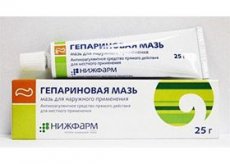Medical expert of the article
New publications
Preparations
Heparin ointment
Last reviewed: 03.07.2025

All iLive content is medically reviewed or fact checked to ensure as much factual accuracy as possible.
We have strict sourcing guidelines and only link to reputable media sites, academic research institutions and, whenever possible, medically peer reviewed studies. Note that the numbers in parentheses ([1], [2], etc.) are clickable links to these studies.
If you feel that any of our content is inaccurate, out-of-date, or otherwise questionable, please select it and press Ctrl + Enter.

Release form
The drug is an ointment that is used externally. The medicine is produced in aluminum tubes of different weights - twenty-five, thirty and fifty grams. The tubes are placed in cardboard packaging. The medicine is also produced in plastic tubes of ten grams, enclosed in cardboard packaging. The drug is produced in jars with a capacity of twenty-five grams of the drug, made of dark glass and placed in a cardboard box. There is also a form of release of the drug in a blister pack of ten or twenty grams, placed in a cardboard package.
One gram of Heparin ointment contains ten thousand units of heparin, four grams of anesthesin, eighty milligrams of benzyl nicotinate. The excipients listed include Vaseline, glycerin, cosmetic stearin group "D", emulsifier number one, peach oil, nipazole, nipagin, purified water.
Pharmacodynamics
The components of Heparin ointment penetrate well into the body, being absorbed through the skin and mucous membranes. In this case, sodium heparin is released, which helps block the production of thrombin and reduce platelet aggregation. The drug has a depressing effect on the activity of such an enzyme as hyaluronidase. There is also an increase in the fibrinolytic properties of the blood. The content of benzyl alcohol nicotinic acid in the drug acts on small superficial vessels in a dilating manner, which leads to a more active absorption of heparin.
Pharmacokinetics
The maximum concentration of the active substance in the blood plasma is observed three or four hours after the procedure. The properties of heparin include poor penetration through the placental barrier, since the substance has a large molecular weight. Not found in breast milk. The half-life of Heparin ointment from blood plasma is from half an hour to one hour.
Dosing and administration
Heparin ointment is applied externally. The medicine should be applied in a thin layer to the desired area of skin. The amount of ointment per area with a diameter of three to five centimeters is from half to one gram. This procedure should be done two or three times a day until the pain disappears. Usually, the course of treatment is from three to seven days.
Use Heparin ointment during pregnancy
During this period, Heparin ointment is used only as prescribed by a specialist and under his personal supervision. During the lactation period, the use of the ointment is possible if the patient is under the supervision of a doctor.
Contraindications
- The presence of hypersensitivity to the components of Heparin ointment.
- History of various disorders that affect blood clotting levels.
- The patient has thrombocytopenia - decreased platelet production.
- The presence of ulcerative-necrotic phenomena in the required area of the skin, as well as thrombophlebitis lesions.
- It is prohibited to use the ointment to treat open and festering wounds.
Side effects Heparin ointment
- Allergic reactions – the appearance of reddening of the skin, itching, hives, swelling, the appearance of dermatitis on the treated area of the skin, as well as itching of the skin and an increase in local temperature in the area of the feet, the occurrence of drug fever, rhinitis, bronchospasm, collapse and anaphylactic shock.
- Digestive system – occurrence of nausea and vomiting, diarrhea, loss of appetite, presence of increased activity of liver transaminases.
- Circulatory system – possibility of bleeding from the gastrointestinal tract and urinary tract, as well as bleeding at the site of application of the ointment; bleeding in other organs occurs; hematuria and thrombocytopenia may occur.
- Musculoskeletal system - long-term use of the drug leads to the development of osteoporosis, spontaneous fractures, and calcification of soft tissues.
Interactions with other drugs
The action of the main component can be enhanced by such drugs as anticoagulants, antiplatelet agents and non-steroidal anti-inflammatory drugs. It is prohibited to use Heparin ointment in combination with other non-steroidal anti-inflammatory drugs. The same prohibition applies to antibiotics from the tetracycline group and antihistamines. The action of ergot alkaloids, thyroxine, tetracyclines, antihistamines, and nicotine helps to reduce the activity of the main component of the ointment.
Attention!
To simplify the perception of information, this instruction for use of the drug "Heparin ointment" translated and presented in a special form on the basis of the official instructions for medical use of the drug. Before use read the annotation that came directly to medicines.
Description provided for informational purposes and is not a guide to self-healing. The need for this drug, the purpose of the treatment regimen, methods and dose of the drug is determined solely by the attending physician. Self-medication is dangerous for your health.


 [
[